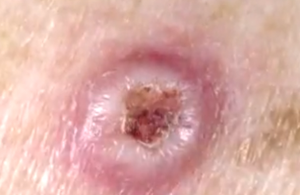Keratoacanthoma is an active type of skin cancer characterized by the occurrence of volcano-shaped lumps, with a tendency to grow rapidly. It is widely accepted by the medical community that keratoacanthomas belong to the less severe kind of squamous cell carcinoma.Generally keratoacanthomas affects the skin of middle aged people as well as the elderly. In most cases, they do restrictive damage to the skin. However in some cases keratoacanthomas has been found to be aggressive with a tendency to spread to the lymph nodes.
Symptoms
Some signs and symptoms of keratoacanthomas are given as under:
- Initially the keratoacanthomas shoot out in the form of a lesion, with a similar look of a pimple. In due course of time, it develops into a skin colored dome shaped bump with a dent in the center. The matter is composed of protein backed keratins which are usually present in hair, nails and skin.
- These form and grow rapidly over the skin within two to six weeks.
- In rare cases, more number of keratoacanthomas may occur as a sign of more adverse disorder.
- Keratoacanthomas differ in size, measuring 1 to 2.5 centimeters
- Generally, they are painless; however few can be very itchy and painful. Depending on the location of keratoacanthomas over the skin, the function of the affected body part may get impaired.
- Mostly the keratoacanthomas occur on scalp, hands, middle of face, forearms, and on ears. They may also develop on the lower legs, particularly in women.
Causes
Technically, keratoacanthomas tend to affect the fair skinned, aged people who have had prolonged exposure to sunlight in the past.
The following are some of the risk factors which can increase the formation of keratoacanthomas:
- Continuous exposure to sunlight or to other variants of ultraviolet light
- The cancer patients of internal glands, who have undergone radiation therapy are at greater risk
- People who are in contact with harmful chemicals such as tar
- An increased age of more than 50 years
- Long time suppression ofthe immune system, such as that occurring post organ transplantation
- People with continuous ulcers are also at greater risk to developing keratoacanthomas
- People with prolonged scars, such as gasoline burns
- People with cancer history
- People infected with wart virus such as human papillomavirus
- In comparison to women, the male population is at are more affected
- Presence of light hair, light eye, or fair skin may elevate the susceptibility to this skin cancer
Treatment of keratoacanthomas
These lumps automatically fade away within six months leaving a scar on the spot and causing damage to the tissues occurring underneath the keratoacanthoma affected skin. The resultant cosmetic damage may cause mental agony to the patients
Sometimes the rare types of keratoacanthomas forcefully penetrate deep into the skin and affect the lymph nodes. As such it is better to consult the doctor for all cases of keratoacanthomas for correct diagnosis.
Once an extra growth over the sun exposed skin is noticed, it is recommended for affected individuals to go for diagnostic tests. Under the following circumstances one should not fail to go for tests:
- When bleeding is noticed on a spot
- When such spots fail to heal
- When the texture of the spot get altered
- When its shape, size and color undergo changes
- When it becomes sore and tender, and
- When it starts itching or bleeding
When the diagnosis confirms about the presence of keratoacanthomas, the affected patients should go for the following treatment procedures:
- Surgical elimination of the keratoacanthomas. The resultant operation injury is then stitched up.
- Adopting cryosurgery to destroy the keratoacanthomas by freezing it by the use of liquid nitrogen.
- Adopting an advanced and special type of surgery called Mohs micrographic surgery. It involves removal of tiny pieces of skin affected by keratoacanthomas. This type of surgery is much helpful for removing the keratoacanthomas that occur over the nose, lips, hands, and ears.
- Removal of cancer by radiation therapy in which intensive radiation beams are precisely directed to kill the cancer cells.
- Oral isotretinoin is advised for those patients who have two or more keratoacanthomas lesions,so as to control its number, and also manage the size of unwanted cancer growth. In rare cases, the direct use of chemotherapy drugs is advised for keratoacanthomas.
Even after the successful removal of keratoacanthomas, one has to go for regular checkups for detection and correction of any relapse. The patients are required to observe the below listed self-care measures, for not only for blocking the relapse, but also for preventing fresh cases of keratoacanthomas.
- During the period of outdoor activities, one should apply sunscreen on skin, with SPF 30 or more.
- During sunny period, avoid outdoor ventures, between 10 AM to 3 PM.
- Keep away from continuous contact with ultraviolet rays of the sun and from other artificial tanning machines.
- One should prefer to wear full sleeve shirts and wide brimmed hats.
Keratoacanthoma Pictures


We’re a group of volunteers and opening a brand new scheme in our community. Your web site provided us with valuable information to work on. You’ve done an impressive job and our entire community might be grateful to you.